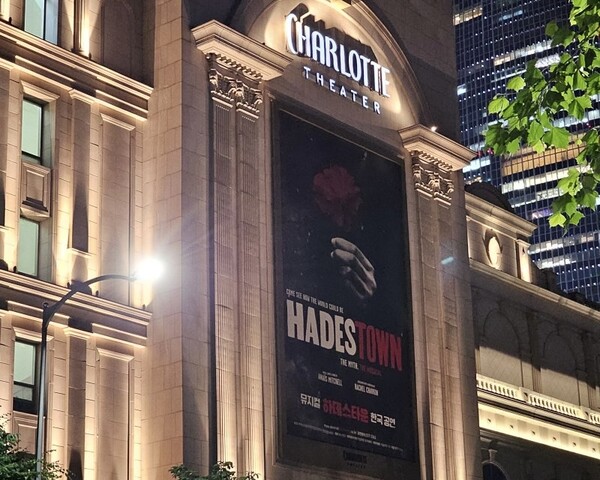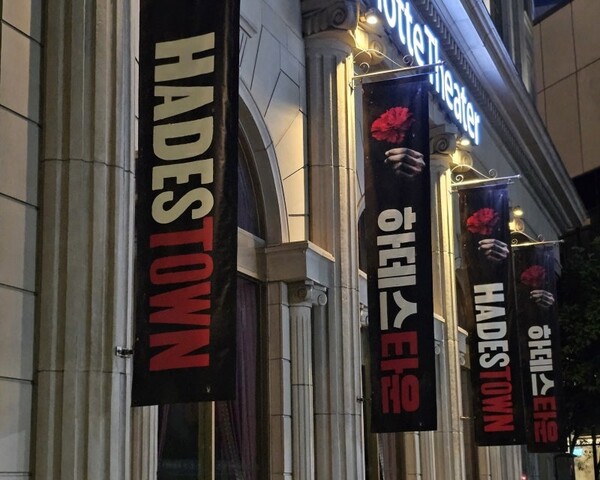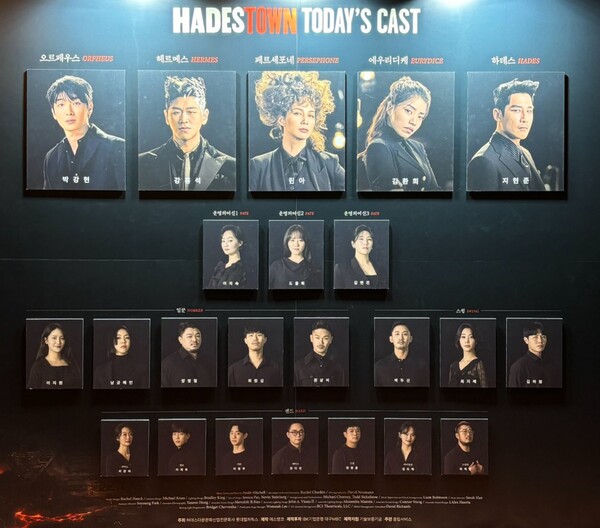
“Hadestown” is a musical that blends Greek mythology with modern elements, offering a unique and immersive experience. As the stories of Orpheus and Eurydice, and Hades and Persephone intertwine, the work explores themes of love, sacrifice, and destiny, leaving a profound emotional impact on its audience.
“Hadestown” premiered from September 7th, 2021, to February 27th, 2022, and had a reprise performance from July 12th to October 6th, 2024. At the 9th Annual Korean Musical Awards held on January 13th, 2025, Kim Soo-ha, who played Eurydice, won the Best Actress Award, while Choi Jeong-won, who portrayed the first-ever gender-neutral Hermes in Korea, won the Best Supporting Actress Award. Kim Min-seok, known for his work in MeloMance, won the Best New Actor Award for his role as Orpheus. Additionally, “Hadestown” won several awards, including Best Stage Art, Best Arrangement, Best Music Director, and Best Stage Art (Stage Director Category), further acknowledging the production’s artistic and creative excellence.

Way Down Hadestown: Love, sacrifice, and repetition
The young, free-spirited musician Orpheus falls in love at first sight with the wandering woman Eurydice and proposes to her. Before summer has even passed, Hades takes Persephone to his realm, Hadestown, causing Persephone’s absence to bring winter to the earth. Orpheus realizes that the reason winter has become so harsh is because the love between Hades and Persephone has faded, and their song of love has disappeared. He becomes absorbed in completing the song, “Epic”, of love they had forgotten, neglecting Eurydice.
Meanwhile, Eurydice, concerned about survival, succumbs to Hades’ temptation and contracts with him, realizing too late that she can no longer return to the surface and regrets her decision. To rescue her, Orpheus embarks on a long journey to confront the king of the underworld, Hades, demanding that he allow Eurydice to return. Orpheus sings the song of love they had lost, moving Hades’ heart, and Hades agrees to let Eurydice go. However, Hades does not want to give up his love for Persephone or the order of Hadestown. To test their love and obsession with doubt, Hades sets a condition: until they reach the surface, Orpheus must not look back at Eurydice. If he does, Eurydice will be trapped in Hadestown forever.
Orpheus gradually becomes consumed by doubt, wondering if Eurydice will follow him, if she will abandon him on the long, difficult journey, or if Hades never intended to let her go. Finally, just after crossing the exit to the surface, Orpheus can no longer hold back and turns around. At that moment, Eurydice is still behind him. As a result, Eurydice falls back into Hadestown and remains there forever. Hermes reflects that the tragic fate of the two lovers was written long ago, and while the conclusion is inevitable, he continues to sing their story, emphasizing that there is meaning in hoping for the ending to change, and concludes the tale.
In the original Greek myths, there are no specific details about where Orpheus met his beloved Eurydice or how he proposed to her. Shortly after their wedding, Eurydice was walking through a meadow with her attendants when she was bitten by a venomous snake and died on the spot. Unable to bear the grief of losing his bride, Orpheus decided to descend to the underworld to bring her back. Upon reaching the underworld, Orpheus played his lyre, and it is said that the beautiful melody mesmerized all the beings in the underworld, making them hold their breath. As Orpheus neared the surface, he hastily turned around. At that moment, Eurydice, who had not yet reached the surface, slipped back into the darkness and returned to the underworld. In that fleeting instant, Orpheus heard a single word from his wife as he reached out toward her: “Goodbye.”
The musical stays true to the original story in most aspects while introducing several important changes. In the original myths, the love story between Orpheus and Eurydice is not explored in detail; the focus is primarily on their tragedy. In addition, there is no mention of factories created by Hades in the underworld or walls built to protect his town. Instead, the musical introduces a new concept where the relationship between Persephone and Hades deteriorates, causing the seasons on Earth to no longer function properly. Through these creative additions, the gaps in the original myth are filled with imaginative elements.
The opening number of the musical truly encapsulates everything about the production. In Greek and Roman mythology, Hermes serves as the messenger and guide of Zeus, and in “Road to Hell,”- he introduces the characters and explains the unfolding story, kicking off the performance. As hinted in the first number, the journey of Orpheus and Eurydice ultimately leads to a tragic conclusion. However, the “failed escape from Hadestown” that Orpheus and Eurydice experience in this musical is not a simple tragedy. If we view the play as a love story between Hades and Persephone, the reason becomes clear. By sharing the story of Orpheus and Eurydice’s love with the two people during a relationship crisis, the musical rekindles their bond, making it a more hopeful message. The relationship between Hades and Persephone mirrors that of Orpheus and Eurydice, except with the genders reversed.
Hades, knowing that he and Persephone may not be well-matched, confesses his love to her, takes her to the underworld, and continues to build a castle to protect and make her happy. However, the way he expresses his love is not what Persephone wants, and as a result, she begins to break mentally, while Hades becomes absorbed in fortifying Hadestown, unsure of what else to do. This mirrors Eurydice’s situation just like Hades. Just as she offers food and firewood to support Orpheus in creating his “epic” song, Orpheus, oblivious to her pain, does not appreciate her efforts. In the end, like Eurydice weary of it all, she boards the train to Hadestown. Like Hades, who traps himself in Hadestown, Eurydice too ends up retreating into that fortress-like place.
The reason this play is hopeful lies in the fact that both Persephone and Orpheus refuse to give up on love. When Orpheus sets out to bring Eurydice back from Hadestown, it mirrors the very image Hades had dreamed of: Persephone coming back to him on her own. During the six months that Persephone was away on Earth, Hades, in fact, was no different from Eurydice, losing himself in work and forgetting her name. Of course, by the end, Hades experiences pain once again. He must endure the separation from his beloved Persephone for six months, which crushes him. To convey this pain to Persephone, Orpheus walks through an endless darkness, guided only by his belief in Eurydice.
Therefore, the conclusion of this musical is not a mere tragedy. The suffering Orpheus endures while walking through the long darkness is something Persephone would come to understand, and Eurydice, longing to see him, must have felt the same anguish that Hades did, waiting for Persephone while stepping back toward Hadestown. As the mood of the play lightens in contrast to the beginning, it becomes clear that, just like the cycles of the seasons, Hades and Persephone will fall in love once more.

Journeying through Hadestown with lighting, stage design, and music
The key elements that effectively convey the story of the musical Hadestown are lighting and stage design. Hadestown perfectly portrays the journey between the underworld and the surface without significant changes to the stage background. The stage floor is surrounded by two circular belts, with a central circle as a pivot point, creating a turntable-style stage. This allows Orpheus’s journey toward the underworld to be expressed as an infinite journey. While Broadway and the West End use lifts to descend into the underworld, the Korean Hadestown distinguishes between the underworld and the surface world with a door at the back of the stage. This difference in stage direction does not disrupt the immersion of the play.
The journey to the underworld is effectively realized through lighting that adjusts the height. The actors continuously walk on the circular table, and the lighting changes height, creating the illusion of physically descending into the underworld. This lighting, paired with the actors’ movements, perfectly portrays the main plot of descending into and ascending from the underworld without the need for changing backgrounds.
In addition, the lighting design of the popular number “Wait for Me” is nothing short of mesmerizing. The workers, holding lamps, appear one by one to the beat, hanging the lamps from the ceiling and directing them toward the audience. The accompanying enchanting voice of the actor makes it one of the most captivating moments. The lights swing in a pendulum motion and soar toward the audience, offering a unique experience for those seated in the front rows. Rachel Chavkin, the director of Hadestown, explained that the shaking lamps were designed to evoke the image of headlights of cars passing on the highway, symbolizing the headlights illuminating the path to the underworld.
The temporal and spatial setting of Hadestown is ambiguous. The stage is small, and the movement of the characters is not expansive. There are no extravagant scene changes or effects commonly seen in large-scale musicals. The performance primarily takes place in the surface world, reminiscent of a jazz bar by a train station, and the underworld where Hades resides. However, in scenes where characters move between the surface and the underworld, stage design and lighting play an important role in enriching the otherwise simple set. This stage direction played a significant role in Hadestown winning the “Best Scenic Design” and “Best Lighting Design” at the 73rd Tony Awards.
Another strength of Hadestown is its numbers. As a sung-through musical, its melodies and lyrics are crucial to the performance. Another indispensable element in Hadestown is the seven-piece band. Unlike traditional musicals where the orchestra is placed below the stage and not visible to the audience, the band members of Hadestown perform on stage as part of the show. Their presence and performance add tremendous energy to the production, and the seven-piece band, which stays on stage even after the curtain call, provides a hidden but significant highlight of the performance. The unique musical numbers, different from traditional musicals, contributed to Hadestown sweeping all music-related categories, including “Original Score,” “Sound Design,” and “Orchestrations” at the Tony Awards.
There are stories that, even though we already know the tragic ending, we keep returning to. Some works, even when the conclusion is known, still draw us back. They sing in the dark, like a dead night, and bloom in the cold, barren snow, offering support and comfort to those who endure. For those hesitant to love, for those suffering from a love left unspoken, they bring a promise of return. It is an old, worn-out tale of tragic love that does not just pass by but echoes deeply in the heart.
Looking at Eurydice’s fragile arm, we feel the coldness in my own; trembling at Orpheus’ tension, our hands shake; burdened by the oppression Hades endures, our shoulders feel heavy; our heart aches with Persephone’s pain. All of this is conveyed through Hermes’ voice, making our hearts resonate. And so, we wait for that love story to return. In this tender reality, where all love, youth, and hearts gently bloom, I honor them and say, “Good night, brothers, good night.”
I hope this story comforts and encourages you and me as we raise our cups to it.

